Recurrent Neural Networks
- 循环神经网络很像前向神经网络,但是不同的是神经元有连接回指。
- 循环神经网络用LSTM和GRU单元解决梯度爆炸\消失问题
循环神经元(Recurrent Neurons)
如图左边,一个循环神经元可以把自己的输出,作为自身的输入,但是这个输入是上一个时间戳(previous time step)的输出结果,如果照着时间戳展开(unrolled through time)便是右图:这是一个神经元在时间轴上的运行。
图右边的下标代表时间,循环神经元在时间 t t 同时接受输入 和自己在上一时间 t−1 t − 1 的输出结果 y(t−1) y ( t − 1 ) 。

把许多循环神经元堆成一层的结构,解释下,图左边得到的输出都被回指作为下一时间戳的输入,图右边是一层沿着时间戳展开的模样:
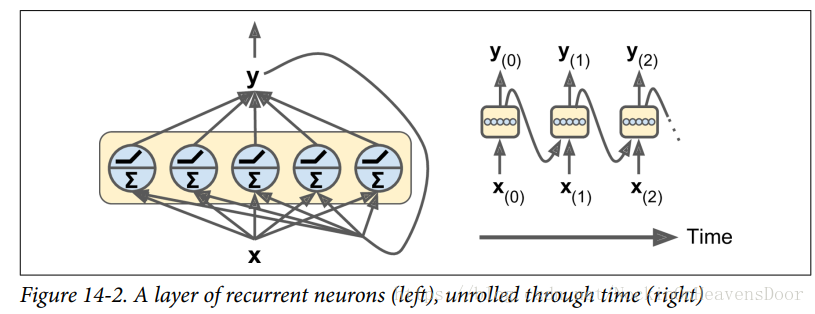
每个循环神经元都有两组权重:
Wx
W
x
代表与输入
x(t)
x
(
t
)
相乘的权重,
Wy
W
y
代表与输入
y(t−1)
y
(
t
−
1
)
相乘的权重。
每个神经元的输出计算公式:
Equation 14-1: Output of a single recurrent neuron for a single instance
其中 ϕ(⋅) ϕ ( ⋅ ) 代表激活函数(tanh或者ReLU); b b 是偏置值。
进一步得到每一层批量训练的输出,即向量化的输出公式:
Equation 14-2: Outputs of a layer of recurrent neurons for all instances in a mini-batch
- Y(t) Y ( t ) 是 m×nneurons m × n n e u r o n s 矩阵, m m 是批量大小, 是每层神经元数目, t t 是时间戳。
- 是 m×ninputs m × n i n p u t s 矩阵,其中 ninputs n i n p u t s 代表特征维度(数目)(如一个mnist图片的特征维度是28*28)。
- Wx W x 是 ninputs×nneurons n i n p u t s × n n e u r o n s 的矩阵
- Wy W y 是 nneurons×nneurons n n e u r o n s × n n e u r o n s 的矩阵
- b b 是 nneurons n n e u r o n s 大小的向量。
注: t=0 t = 0 时没有输出值时,所以设这时候的公式中的输出值都为 0 0 .
上图实现的代码(两个时间戳,输入向量大小为3,层内由五个循环神经元组成):
n_inputs = 3
n_neurons = 5
# 时间0和时间1的输入
X0 = tf.placeholder(tf.float32, [None, n_inputs])
X1 = tf.placeholder(tf.float32, [None, n_inputs])
# Wx是输入的权值,Wy是输出到下一个时间的权值
Wx = tf.Variable(tf.random_normal(shape=[n_inputs,n_neurons],dtype=tf.float32))
Wy = tf.Variable(tf.random_normal(shape=[n_neurons, n_neurons], dtype=tf.float32))
b = tf.Variable(tf.zeros([1, n_neurons], dtype=tf.float32))
Y0 = tf.tanh(tf.matmul(X0, Wx) + b)
# Y0作为下一个时间1的输入
Y1 = tf.tanh(tf.matmul(Y0,Wy) + tf.matmul(X1,Wx) + b)
init = tf.global_variables_initializer()
import numpy as np
X0_batch = np.array([[0, 1, 2], [3, 4, 5], [6, 7, 8], [9, 0, 1]]) # t = 0
X1_batch = np.array([[9, 8, 7], [0, 0, 0], [6, 5, 4], [3, 2, 1]]) # t = 1
with tf.Session() as sess:
init.run()
Y0_val, Y1_val = sess.run([Y0, Y1], feed_dict={X0:X0_batch, X1:X1_batch})
print("Y0_val:\n",Y0_val,"\n\n\n","Y1_val:\n",Y1_val)
输出:
Y0_val:
[[-0.0664006 0.9625767 0.68105793 0.7091854 -0.898216 ]
[ 0.9977755 -0.719789 -0.9965761 0.9673924 -0.9998972 ]
[ 0.99999774 -0.99898803 -0.9999989 0.9967762 -0.9999999 ]
[ 1. -1. -1. -0.99818915 0.9995087 ]]
Y1_val:
[[ 1. -1. -1. 0.4020025 -0.9999998 ]
[-0.12210421 0.6280527 0.9671843 -0.9937122 -0.25839362]
[ 0.9999983 -0.9999994 -0.9999975 -0.8594331 -0.9999881 ]
[ 0.99928284 -0.99999815 -0.9999058 0.9857963 -0.92205757]]用static_rnn()实现:
n_inputs = 3
n_neurons = 5
reset_graph()
X0 = tf.placeholder(tf.float32, [None, n_inputs])
X1 = tf.placeholder(tf.float32, [None, n_inputs])
basic_cell = tf.contrib.rnn.BasicRNNCell(num_units=n_neurons)
output_seqs, states = tf.contrib.rnn.static_rnn(basic_cell, [X0, X1], dtype=tf.float32)
Y0,Y1 = output_seqs
X0_batch = np.array([[0, 1, 2], [3, 4, 5], [6, 7, 8], [9, 0, 1]])
X1_batch = np.array([[9, 8, 7], [0, 0, 0], [6, 5, 4], [3, 2, 1]])
init = tf.global_variables_initializer()
with tf.Session() as sess:
init.run()
Y0_val, Y1_val = sess.run([Y0, Y1], feed_dict={X0: X0_batch, X1: X1_batch})
print("Y0_val:\n",Y0_val,"\n\n\n","Y1_val:\n",Y1_val)
输出:
Y0_val:
[[ 0.30741334 -0.32884315 -0.6542847 -0.9385059 0.52089024]
[ 0.99122757 -0.9542542 -0.7518079 -0.9995208 0.9820235 ]
[ 0.9999268 -0.99783254 -0.8247353 -0.9999963 0.99947774]
[ 0.996771 -0.68750614 0.8419969 0.9303911 0.8120684 ]]
Y1_val:
[[ 0.99998885 -0.9997605 -0.06679298 -0.9999804 0.99982214]
[-0.6524944 -0.51520866 -0.37968954 -0.59225935 -0.08968385]
[ 0.998624 -0.997152 -0.03308626 -0.9991565 0.9932902 ]
[ 0.99681675 -0.9598194 0.39660636 -0.8307605 0.7967197 ]]BasicRNNCell:类似于一个单元工厂,拷贝由循环神经元组成的记忆单元( memory cell )来建立延时间轴展开的RNN,即每一个时间戳对应一个BasicRNNCell。static_rnn:每一个input tensor(这里是 [X0,X1] )就调用一次单元工厂的__call__()方法创建一个记忆单元(这里是一层包含着5个循环神经元),然后把这组单元(这里是两层记忆单元)像之前延时间展开一样串联起来,这些层都共享权重和偏执参数。还有一个参数是数据类型,表示初始化状态矩阵(默认都是0初始化)。返回包含每一个时间戳的outputs tensors的list,和整个网络最后state的tensor;BasicRNNCell的最后状态等于最后输出。
下面考虑建立更多时间戳的RNNs,而不用写太多的placehold上去:
- 如果有50个时间戳的话,这样就得用手动写50个placehold,解决方法是设placehold的
shape为 [None,n_steps,n_inputs],注意上面的 [X0,X1] 创建两个单元工厂,其shape实际是 [2 (n_steps) , None, n_inputs]. - 最后用
tf.stack把全部的输出叠加起来,做相同的矩阵变换得到最后的输出形状 [None,n_steps,n_neurons],因为矩阵变换前,第一维是n_steps个时间戳,然后是[None,n_neurons]。
代码如下:
n_steps = 2
n_inputs = 3
n_neurons = 5
reset_graph()
X = tf.placeholder(tf.float32, [None, n_steps, n_inputs])
X_seqs = tf.unstack(tf.transpose(X,perm=[1, 0 , 2]))
basic_cell = tf.contrib.rnn.BasicRNNCell(num_units=n_neurons)
output_seqs, states = tf.contrib.rnn.static_rnn(basic_cell, X_seqs, dtype=tf.float32)
outputs = tf.transpose(tf.stack(output_seqs),perm=[1,0,2])
init = tf.global_variables_initializer()
#注意这里t=0输入数据的存放位置
X_batch = np.array([
# t = 0 t = 1
[[0, 1, 2], [9, 8, 7]], # instance 1
[[3, 4, 5], [0, 0, 0]], # instance 2
[[6, 7, 8], [6, 5, 4]], # instance 3
[[9, 0, 1], [3, 2, 1]], # instance 4
]) # X_batch.shape : (4, 2, 3) 即 [None, n_steps, n_inputs]
with tf.Session() as sess:
init.run()
outputs_val = outputs.eval(feed_dict={X: X_batch})
print(outputs_val)
输出:
[[[-0.45652324 -0.68064123 0.40938237 0.63104504 -0.45732826]
[-0.94288003 -0.9998869 0.94055814 0.9999985 -0.9999997 ]]
[[-0.8001535 -0.9921827 0.7817797 0.9971031 -0.9964609 ]
[-0.637116 0.11300932 0.5798437 0.43105593 -0.63716984]]
[[-0.93605185 -0.9998379 0.9308867 0.9999815 -0.99998295]
[-0.9165386 -0.9945604 0.89605415 0.99987197 -0.9999751 ]]
[[ 0.9927369 -0.9981933 -0.55543643 0.9989031 -0.9953323 ]
[-0.02746334 -0.73191994 0.7827872 0.9525682 -0.97817713]]]
- 更简单的方法使用
dynamic_rnn:动态单元在每一个时间戳接受tensor [None,n_steps,n_inputs],在每个时间戳输出tensor [None,n_steps,n_neurons],这样就不用像上面一样对数据做变换了。
可以避免 OOM errors,可设置swap_memory=True加入内存预防报错。
代码:
n_steps = 2
n_inputs = 3
n_neurons = 5
reset_graph()
X = tf.placeholder(tf.float32, [None, n_steps, n_inputs])
basic_cell = tf.contrib.rnn.BasicRNNCell(num_units=n_neurons)
# 动态单元在每一个时间戳接受tensor[None,n_steps,n_inputs],在每个时间戳输出tensor[None,n_steps,n_neurons]和状态tensor[None,n_steps]
outputs, states = tf.nn.dynamic_rnn(basic_cell, X, dtype=tf.float32)
init = tf.global_variables_initializer()
X_batch = np.array([
[[0, 1, 2], [9, 8, 7]], # instance 1
[[3, 4, 5], [0, 0, 0]], # instance 2
[[6, 7, 8], [6, 5, 4]], # instance 3
[[9, 0, 1], [3, 2, 1]], # instance 4
])
with tf.Session() as sess:
init.run()
outputs_val = outputs.eval(feed_dict={X:X_batch})
print(outputs_val)
输出:
[[[-0.85115266 0.87358344 0.5802911 0.8954789 -0.0557505 ]
[-0.9999959 0.9999958 0.9981815 1. 0.37679598]]
[[-0.9983293 0.9992038 0.98071456 0.999985 0.2519265 ]
[-0.70818055 -0.07723375 -0.8522789 0.5845348 -0.7878095 ]]
[[-0.9999827 0.99999535 0.9992863 1. 0.5159071 ]
[-0.9993956 0.9984095 0.83422637 0.9999999 -0.47325212]]
[[ 0.87888587 0.07356028 0.97216916 0.9998546 -0.7351168 ]
[-0.91345143 0.36009577 0.7624866 0.99817705 0.80142 ]]]
记忆单元(Memory Cells)
循环神经元的输出是一个对之前所有输入的函数,所以可以认为它有一定的记忆形式,这样通过时间保留一定记忆的形式称为记忆单元(cells)。单个循环神经元或者一层循环神经元都可以称为记忆单元,记在时间戳 时的单元状态为 h(t) h ( t ) ,有 h(t)=f(h(t−1),x(t)) h ( t ) = f ( h ( t − 1 ) , x ( t ) ) ,所以RNNs的最后状态相当于是包含之前所有状态的函数。
如图,一般情况下,简单的单元状态 h(t) h ( t ) 等于最后一个时间戳的输出 y(t) y ( t ) ,但是也不一定是这种情况:
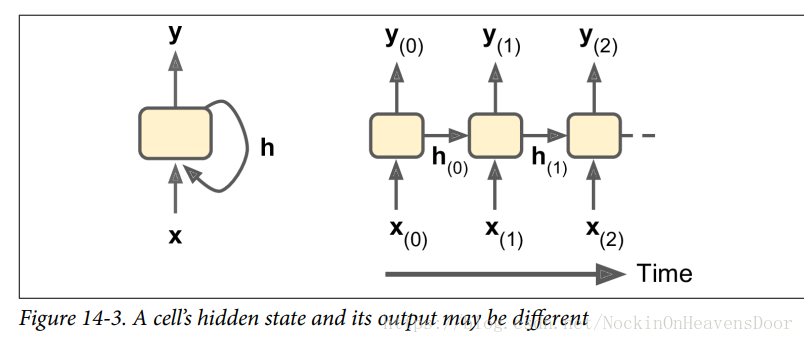
输入和输出序列
如图是几种常见的输入输出形式:

图左上角:例子是股票价格,你给它喂过去 N N 天的价格,它输出在未来一天内的价格(即从 天前到明天)。
图右上角:例子是向网络输入与电影评论相对应的一系列单词,网络将输出一个情感评分 (e.g.,from –1 [hate] to +1 [love]).
图左下角:例如,输入可以是图像,输出可以是该图像的标题。
图右下角:例子是把某一语言中的句子翻译成另一种语言下的同义语句。即序列到向量(seq to vector)的网络作为编码器,对要编译的语言进行编码,然后把得到的向量作为向量到序列(seq to seq)的解码器的输入拿来解码成为序列,这比左上角的序列到序列模型好,因为翻译结果会受到一句话最后的那些单词的影响,所以这在听到整句话之后再进行翻译是比较合理的。
训练输入序列长度可变的的循环神经元
只需要增加dynamic_rnn的参数sequence_length,并且对长度不够的tensor用零值填充,因为输入tensor的第二个维度是最长的那个序列(来自某一个实例)的大小,所以不够长度的其他序列(来自其他实例)都必须用零填充。
代码:
n_steps = 2
n_inputs = 3
n_neurons = 5
reset_graph()
X = tf.placeholder(tf.float32, [None, n_steps, n_inputs])
basic_cell = tf.contrib.rnn.BasicRNNCell(num_units=n_neurons)
seq_length = tf.placeholder(tf.int32, [None])
outputs, states = tf.nn.dynamic_rnn(basic_cell, X, dtype=tf.float32,
sequence_length=seq_length)
init = tf.global_variables_initializer()
X_batch = np.array([
# step 0 step 1
[[0, 1, 2], [9, 8, 7]], # instance 1
[[3, 4, 5], [0, 0, 0]], # instance 2 (padded with zero vectors)
[[6, 7, 8], [6, 5, 4]], # instance 3
[[9, 0, 1], [3, 2, 1]], # instance 4
])
# seq_length:包含训练实例实际长度的数组,在feed_dict时候传过去
seq_length_batch = np.array([2, 1, 2, 2])
with tf.Session() as sess:
init.run()
outputs_val, state_val = sess.run(
[outputs,states],feed_dict={X:X_batch,seq_length:seq_length_batch})
print("outputs_val",outputs_val,"\n","state_val",state_val)
输出:
outputs_val [[[-0.9123188 0.16516446 0.5548655 -0.39159346 0.20846416]
[-1. 0.9567259 0.99831694 0.99970174 0.9651857 ]] # final state
[[-0.9998612 0.6702289 0.9723653 0.6631046 0.74457586] # final state
[ 0. 0. 0. 0. 0. ]] #zero vector
[[-0.99999976 0.8967997 0.9986295 0.9647514 0.9366201 ]
[-0.9999526 0.9681953 0.9600286 0.9870625 0.8545923 ]] # final state
[[-0.96435434 0.99501586 -0.36150697 0.9983378 0.999497 ]
[-0.9613586 0.9568762 0.71322876 0.97729224 -0.09582978]]] # final state
state_val [[-1. 0.9567259 0.99831694 0.99970174 0.9651857 ]
[-0.9998612 0.6702289 0.9723653 0.6631046 0.74457586]
[-0.9999526 0.9681953 0.9600286 0.9870625 0.8545923 ]
[-0.9613586 0.9568762 0.71322876 0.97729224 -0.09582978]]- 注:这里的
state输出对应的位置,因为第二个序列长度为1,所以第二个的最终状态对应在非0的哪一行。
训练一个RNNs分辨Mnist数据集
训练一个RNNs的时候,即用延时间展开的做法然后用反向传播进行损失更新,这被称为 backpropagation through time(BPTT) ,如图:
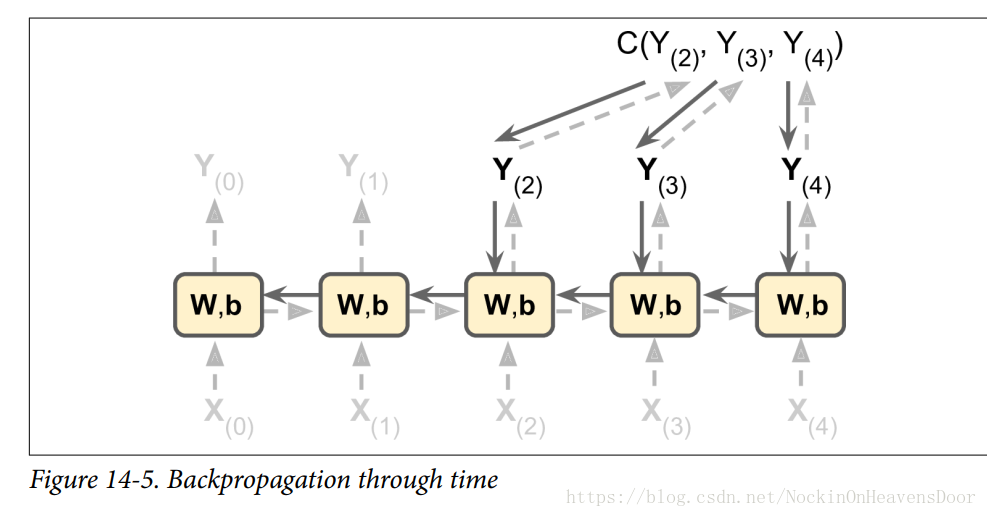
虚线表示正常的前向传播,损失函数的评价是基于 Cost(Y(tmin),Y(tmin+1),......,Y(tmax)) C o s t ( Y ( t m i n ) , Y ( t m i n + 1 ) , . . . . . . , Y ( t m a x ) ) ,这里 tmin t m i n 表示第一个时间戳, tmax t m a x 表示最后一个时间戳,实线表示损失的梯度沿着时间戳反向传播。
- 注:损失函数可以用是用全部时间戳的输出作为函数来计算,图中的损失函数只用了最后三层的输出来计算。
- 注:沿着时间戳展开,每一个时间戳用的权重参数都是同一个权重参数(都有两组权重: Wx W x 代表与输入 x(t) x ( t ) 相乘的权重, Wy W y 代表与输入 y(t−1) y ( t − 1 ) 相乘的权重。)
用Mnist训练RNNs分类器
把每张图片看做由28个时间戳构成的训练数据,每一个时间戳放一组(大小为28)像素(即特征),即28*28的mnist数据集。
每层循环神经元设为150,在最后时间戳的输出做一个全连接层,然后用softmax计算交叉熵作为损失:
如图:
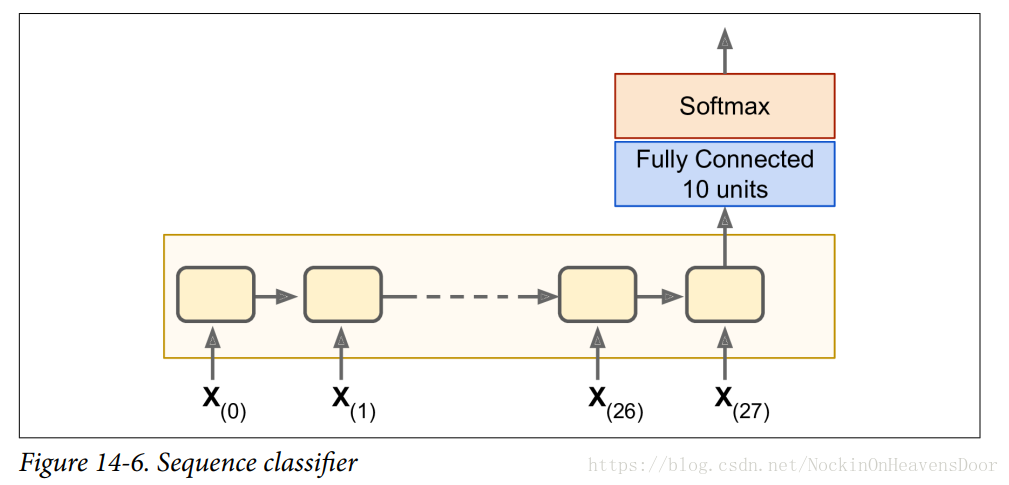
代码:
reset_graph()
n_steps = 28 #时间戳,每个时间戳等于一层
n_inputs = 28 #每层的循环神经元接受的输入数据的个数(等于数据的特征维度)
n_neurons = 150 #每层的循环神经元个数
n_outputs = 10 # 输出
learning_rate = 0.001
X = tf.placeholder(tf.float32, [None, n_steps, n_inputs])
y = tf.placeholder(tf.int32, [None])
basic_cell = tf.contrib.rnn.BasicRNNCell(num_units=n_neurons)
outputs, states = tf.nn.dynamic_rnn(basic_cell, X, dtype=tf.float32)
#全连接层
logits = tf.layers.dense(states,n_outputs)
#做一个softmax
xentropy = tf.nn.sparse_softmax_cross_entropy_with_logits(labels=y,logits=logits)
loss = tf.reduce_mean(xentropy)
optimizer = tf.train.AdamOptimizer(learning_rate)
training_op = optimizer.minimize(loss)
correct = tf.nn.in_top_k(logits, y, 1)
accuracy = tf.reduce_mean(tf.cast(correct, tf.float32))
init = tf.global_variables_initializer()
from tensorflow.examples.tutorials.mnist import input_data
mnist = input_data.read_data_sets("/tmp/data/")
X_test = mnist.test.images.reshape((-1, n_steps, n_inputs))
y_test = mnist.test.labels
n_epochs = 100
batch_size = 150
with tf.Session() as sess:
init.run()
for epoch in range(n_epochs):
for iteration in range(mnist.train.num_examples // batch_size):
X_batch, y_batch = mnist.train.next_batch(batch_size)
X_batch = X_batch.reshape((-1, n_steps, n_inputs))
sess.run(training_op, feed_dict={X:X_batch,y:y_batch})
acc_train = accuracy.eval(feed_dict={X:X_batch,y:y_batch})
acc_test = accuracy.eval(feed_dict={X:X_test,y:y_test})
print(epoch, "Train accuracy:", acc_train, "Test accuracy:", acc_test)
输出:
88 Train accuracy: 1.0 Test accuracy: 0.9797
89 Train accuracy: 0.9866667 Test accuracy: 0.9769
90 Train accuracy: 0.97333336 Test accuracy: 0.9794
91 Train accuracy: 0.98 Test accuracy: 0.9734
92 Train accuracy: 1.0 Test accuracy: 0.9812
93 Train accuracy: 0.9866667 Test accuracy: 0.9759
94 Train accuracy: 0.99333334 Test accuracy: 0.9785
95 Train accuracy: 0.99333334 Test accuracy: 0.9808
96 Train accuracy: 0.9866667 Test accuracy: 0.9805
97 Train accuracy: 0.99333334 Test accuracy: 0.9796
98 Train accuracy: 0.98 Test accuracy: 0.9677
99 Train accuracy: 0.9866667 Test accuracy: 0.9779
多层RNN神经元:tf.contrib.rnn.MultiRnnCell,这样的结构基础上,n_epochs便不用像这么大了。
参考

reset_graph()
n_steps = 28
n_inputs = 28
n_outputs = 10
learning_rate = 0.001
X = tf.placeholder(tf.float32,[None, n_steps, n_inputs])
y = tf.placeholder(tf.int32,[None])
n_neurons = 100
n_layers = 3
layers = [tf.contrib.rnn.BasicRNNCell(num_units=n_neurons,activation=tf.nn.relu)
for layer in range(n_layers)]
multi_layer_cell = tf.contrib.rnn.MultiRNNCell(layers)
outputs , states = tf.nn.dynamic_rnn(multi_layer_cell, X, dtype=tf.float32)
states_concat = tf.concat(axis=1,values=states)
logits = tf.layers.dense(states_concat, n_outputs)
xentropy = tf.nn.sparse_softmax_cross_entropy_with_logits(labels=y, logits=logits)
loss = tf.reduce_mean(xentropy)
optimizer = tf.train.AdamOptimizer(learning_rate)
training_op = optimizer.minimize(loss)
correct = tf.nn.in_top_k(logits, y, 1)
accuracy = tf.reduce_mean(tf.cast(correct, tf.float32))
init = tf.global_variables_initializer()
n_epochs = 10
batch_size = 150
with tf.Session() as sess:
init.run()
for epoch in range(n_epochs):
for iteration in range(mnist.train.num_examples // batch_size):
X_batch, y_batch = mnist.train.next_batch(batch_size)
#分为28个时间戳、每个时间戳放28个特征。
X_batch = X_batch.reshape((-1, n_steps,n_inputs))
sess.run(training_op, feed_dict={X:X_batch, y:y_batch})
acc_train = accuracy.eval(feed_dict={X: X_batch, y: y_batch})
acc_test = accuracy.eval(feed_dict={X: X_test, y: y_test})
print(epoch, "Train accuracy:", acc_train, "Test accuracy:", acc_test)
输出:
0 Train accuracy: 0.98 Test accuracy: 0.9494
1 Train accuracy: 0.97333336 Test accuracy: 0.9655
2 Train accuracy: 0.98 Test accuracy: 0.9739
3 Train accuracy: 0.98 Test accuracy: 0.9732
4 Train accuracy: 0.98 Test accuracy: 0.9727
5 Train accuracy: 0.99333334 Test accuracy: 0.9768
6 Train accuracy: 0.9866667 Test accuracy: 0.9793
7 Train accuracy: 1.0 Test accuracy: 0.9782
8 Train accuracy: 1.0 Test accuracy: 0.98
9 Train accuracy: 0.9866667 Test accuracy: 0.9834
训练RNNs预测时间序列
时间序列:如股票价格、空气温度、脑电图等,如图:
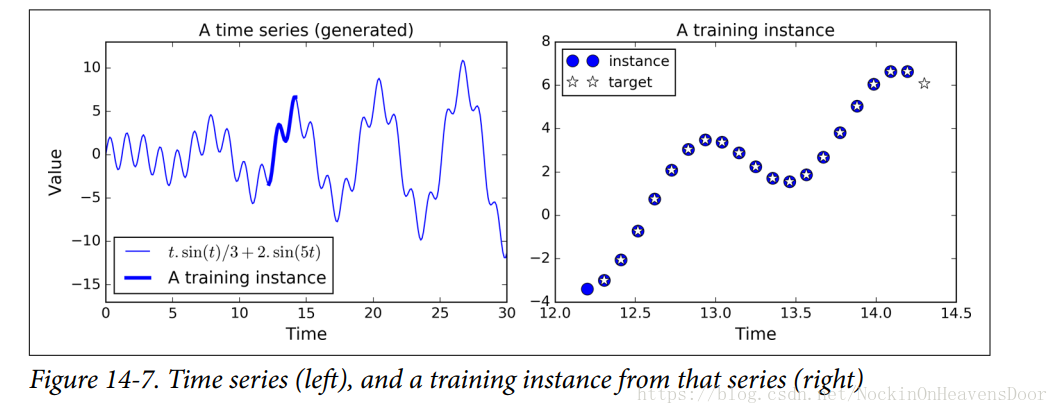
每个训练实例是在时间序列上随机采样的连续20个值,目标序列也是20个值,不过比训练实例往前多一步代表未来的时间戳。
- 训练的RNN包含100个循环神经元、20个时间戳、特征是一维的,即当下时间对应的值:
代码:
t_min, t_max = 0, 30
resolution = 0.1
n_steps = 20
def time_series(t):
return t * np.sin(t) / 3 + 2 * np.sin(t * 5)
def next_batch(batch_size, n_steps):
t0 = np.random.rand(batch_size,1) * (t_max - t_min - n_steps * resolution)
Ts = t0 + np.arange(0. , n_steps + 1) * resolution
ys = time_series(Ts)
#取0-20的样本、然后reshape大小为(n_steps,1)的矩阵元素。
#取1-21的样本,然后reshape大小为(n_steps,1)的矩阵元素。
return ys[:, : -1].reshape(-1, n_steps, 1), ys[:, 1:].reshape(-1, n_steps, 1)
t = np.linspace(t_min, t_max, int( (t_max - t_min) / resolution))
t_instance = np.linspace(12.2, 12.2 + resolution * (n_steps + 1), n_steps + 1)
plt.figure(figsize=(11,4))
plt.subplot(121)
plt.title("A time series (generated)", fontsize=14)
plt.plot(t, time_series(t), label=r"$t . \sin(t) / 3 + 2 . \sin(5t)$")
plt.plot(t_instance[:-1], time_series(t_instance[:-1]), "b-", linewidth=3, label="A training instance")
plt.legend(loc="lower left", fontsize=14)
plt.axis([0, 30, -17, 13])
plt.xlabel("Time")
plt.ylabel("Value")
plt.subplot(122)
plt.title("A training instance", fontsize=14)
plt.plot(t_instance[:-1], time_series(t_instance[:-1]), "bo", markersize=10, label="instance")
plt.plot(t_instance[1:], time_series(t_instance[1:]), "w*", markersize=10, label="target")
plt.legend(loc="upper left")
plt.xlabel("Time")
#save_fig("time_series_plot")
plt.show()X_batch, y_batch = next_batch(1, n_steps)
#样本
np.c_[X_batch[0], y_batch[0]]
输出:
array([[ 0.2291226 , -0.68688911],
[-0.68688911, -1.75200342],
[-1.75200342, -2.72334266],
[-2.72334266, -3.37807267],
[-3.37807267, -3.56765855],
[-3.56765855, -3.25395874],
[-3.25395874, -2.51832451],
[-2.51832451, -1.5414811 ],
[-1.5414811 , -0.55911966],
[-0.55911966, 0.195924 ],
[ 0.195924 , 0.55074475],
[ 0.55074475, 0.43472121],
[ 0.43472121, -0.10322445],
[-0.10322445, -0.90668681],
[-0.90668681, -1.75020522],
[-1.75020522, -2.39465083],
[-2.39465083, -2.64601102],
[-2.64601102, -2.40317736],
[-2.40317736, -1.68303473],
[-1.68303473, -0.61670629]])
每一个时间戳的输出向量是100维(100个神经元的输出),但我们想要的是单独的一个数字,所以需要添加一个全连接层在每一个时间戳的输出上,可以用OuputProjectionWrapper封装cell做到这点,
OuputProjectionWrapper添加无激活函数的线性单元作为全连接层,而且不影响时间戳单元的输出state,注:所有的时间戳的全连接层可训练的权重和偏执(trainable weights and bias)是共享的。
如图:
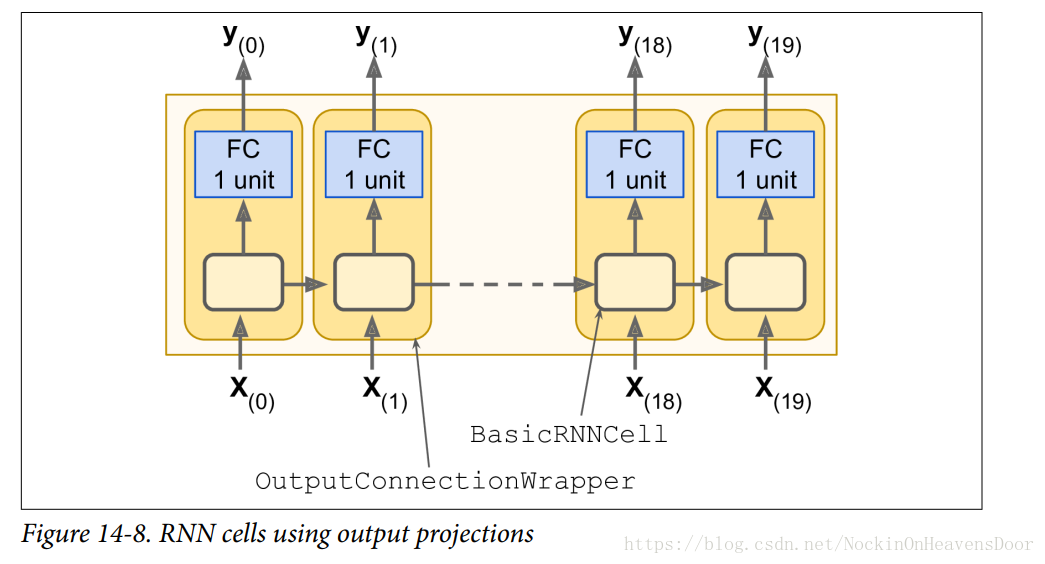
reset_graph()
n_steps = 20
n_inputs = 1
n_neurons = 100
n_outputs = 1
X = tf.placeholder(tf.float32, [None, n_steps, n_inputs])
y = tf.placeholder(tf.float32, [None, n_steps, n_outputs])
cell = tf.contrib.rnn.OutputProjectionWrapper(tf.contrib.rnn.BasicRNNCell(num_units=
n_neurons,
activation=tf.nn.relu),output_size=n_outputs)
outputs , states = tf.nn.dynamic_rnn(cell, X, dtype=tf.float32)
learning_rate = 0.001
loss = tf.reduce_mean(tf.square(outputs - y))
optimizer = tf.train.AdamOptimizer(learning_rate)
training_op = optimizer.minimize(loss)
init = tf.global_variables_initializer()
saver = tf.train.Saver()
n_iterations = 1500
batch_size = 50
with tf.Session() as sess:
init.run()
for iteration in range(n_iterations):
X_batch, y_batch = next_batch(batch_size,n_steps)
sess.run(training_op, feed_dict={X:X_batch, y :y_batch})
if iteration % 100 == 0 or iteration == 1499:
mse = loss.eval(feed_dict={X:X_batch,y:y_batch})
print(iteration,"\tMSE:",mse)
saver.save(sess,"./my_time_series_model")
输出:
0 MSE: 15.725587
100 MSE: 0.5327637
200 MSE: 0.16138169
300 MSE: 0.06723612
400 MSE: 0.06360195
500 MSE: 0.05266063
600 MSE: 0.041647166
700 MSE: 0.04452121
800 MSE: 0.054646917
900 MSE: 0.04342946
1000 MSE: 0.04205539
1100 MSE: 0.038828284
1200 MSE: 0.039993707
1300 MSE: 0.03731156
1400 MSE: 0.034283444
1499 MSE: 0.044869404
预测:
with tf.Session() as sess: # not shown in the book
saver.restore(sess, "./my_time_series_model") # not shown
X_new = time_series(np.array(t_instance[:-1].reshape(-1, n_steps, n_inputs)))
y_pred = sess.run(outputs, feed_dict={X: X_new})
plt.title("Testing the model", fontsize=14)
plt.plot(t_instance[:-1], time_series(t_instance[:-1]), "bo", markersize=10, label="instance")
plt.plot(t_instance[1:], time_series(t_instance[1:]), "w*", markersize=10, label="target")
plt.plot(t_instance[1:], y_pred[0,:,0], "r.", markersize=10, label="prediction")
plt.legend(loc="upper left")
plt.xlabel("Time")
#save_fig("time_series_pred_plot")
plt.show()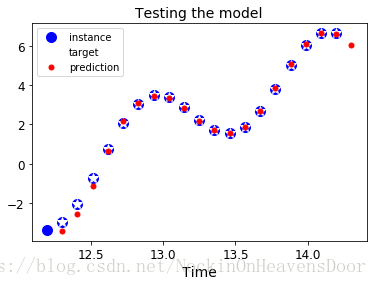
不使用OutputProjectionWrapper的方法,为的是避免每一个时间戳建立一个全连接的层,直接用一个全连接的层对所有的时间戳的批量数据做训练,从而提高效率,如图:
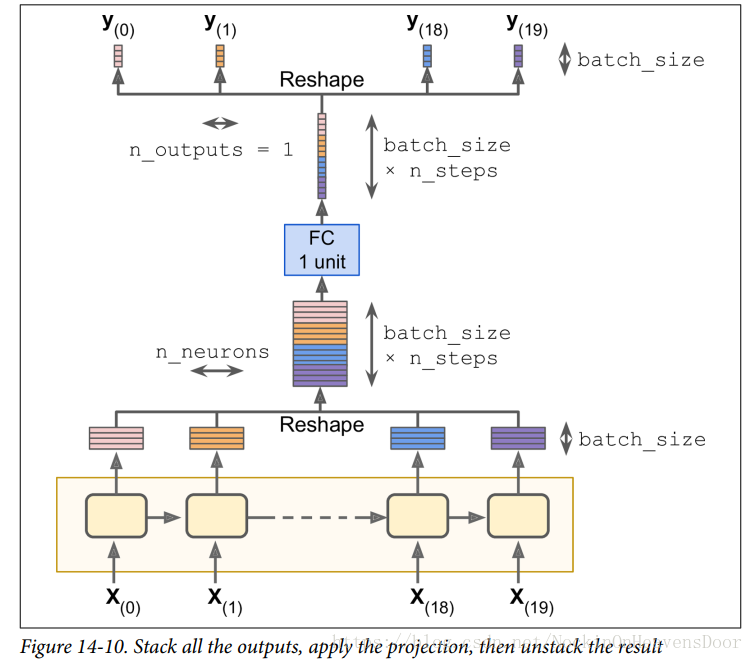
reset_graph()
n_steps = 20
n_inputs = 1
n_neurons = 100
X = tf.placeholder(tf.float32, [None, n_steps, n_inputs])
y = tf.placeholder(tf.float32, [None, n_steps, n_outputs])
cell = tf.contrib.rnn.BasicRNNCell(num_units=n_neurons, activation=tf.nn.relu)
rnn_outputs, states = tf.nn.dynamic_rnn(cell, X, dtype=tf.float32)
n_outputs = 1
learning_rate = 0.001
# [batch_size , n_steps ,n_neurons] reshape为大小 [batch_size * n_steps, n_neurons]
stacked_rnn_outputs = tf.reshape(rnn_outputs, [-1, n_neurons])
# 输出是[batch_size * n_steps ,n_outputs]
stacked_outputs = tf.layers.dense(stacked_rnn_outputs, n_outputs)
# 还原为[batch_size , n_steps ,n_outputs]
outputs = tf.reshape(stacked_outputs, [-1, n_steps, n_outputs])
loss = tf.reduce_mean(tf.square(outputs - y))
optimizer = tf.train.AdamOptimizer(learning_rate)
training_op = optimizer.minimize(loss)
init = tf.global_variables_initializer()
saver = tf.train.Saver()
n_iterations = 1500
batch_size = 50
with tf.Session() as sess:
init.run()
for iteration in range(n_iterations):
X_batch, y_batch = next_batch(batch_size,n_steps)
sess.run(training_op, feed_dict={X:X_batch, y:y_batch})
if iteration % 100 == 0:
mse = loss.eval(feed_dict={X:X_batch, y:y_batch})
print(iteration, "\tMSE:",mse)
X_new = time_series(np.array(t_instance[:-1].reshape(-1, n_steps, n_inputs)))
y_pred = sess.run(outputs, feed_dict={X: X_new})
saver.save(sess, "./my_time_series_model")
plt.title("Testing the model", fontsize=14)
plt.plot(t_instance[:-1], time_series(t_instance[:-1]), "bo", markersize=10, label="instance")
plt.plot(t_instance[1:], time_series(t_instance[1:]), "w*", markersize=10, label="target")
plt.plot(t_instance[1:], y_pred[0,:,0], "r.", markersize=10, label="prediction")
plt.legend(loc="upper left")
plt.xlabel("Time")
plt.show()- 生成新的序列
with tf.Session() as sess:
saver.restore(sess,"./my_time_series_model")
#前20步都是0处
sequence = [0.] * n_steps
for iteration in range(300):
# 一个训练实例,初始化为0
X_batch = np.array(sequence[-n_steps:]).reshape(1, n_steps, 1)
y_pred = sess.run(outputs,feed_dict={X:X_batch})
if iteration == 1:
print(y_pred)
# -1取出最后的state
print(y_pred[0, -1, 0])
#最后的状态加入序列
sequence.append(y_pred[0, -1, 0])
plt.figure(figsize=(8,4))
plt.plot(np.arange(len(sequence)),sequence,"b-")
plt.plot(t[:n_steps] , sequence[:n_steps], "b-", linewidth=3)
plt.xlabel("Time")
plt.ylabel("Value")
plt.show()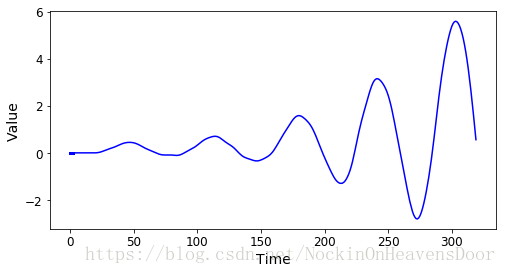
with tf.Session() as sess:
saver.restore(sess, "./my_time_series_model")
sequence1 = [0. for i in range(n_steps)]
for iteration in range(len(t) - n_steps):
X_batch = np.array(sequence1[-n_steps:]).reshape(1, n_steps, 1)
y_pred = sess.run(outputs, feed_dict={X: X_batch})
sequence1.append(y_pred[0, -1, 0])
sequence2 = [time_series(i * resolution + t_min + (t_max-t_min/3)) for i in range(n_steps)]
for iteration in range(len(t) - n_steps):
X_batch = np.array(sequence2[-n_steps:]).reshape(1, n_steps, 1)
y_pred = sess.run(outputs, feed_dict={X: X_batch})
sequence2.append(y_pred[0, -1, 0])
plt.figure(figsize=(11,4))
plt.subplot(121)
plt.plot(t, sequence1, "b-")
plt.plot(t[:n_steps], sequence1[:n_steps], "b-", linewidth=3)
plt.xlabel("Time")
plt.ylabel("Value")
plt.subplot(122)
plt.plot(t, sequence2, "b-")
plt.plot(t[:n_steps], sequence2[:n_steps], "b-", linewidth=3)
plt.xlabel("Time")
#save_fig("creative_sequence_plot")
plt.show()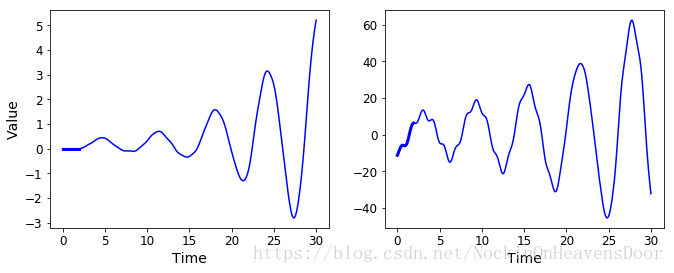
实现深层RNNs
把多个层(每层由许多循环神经元构成)叠加在一起便是Deep RNNs,如图:
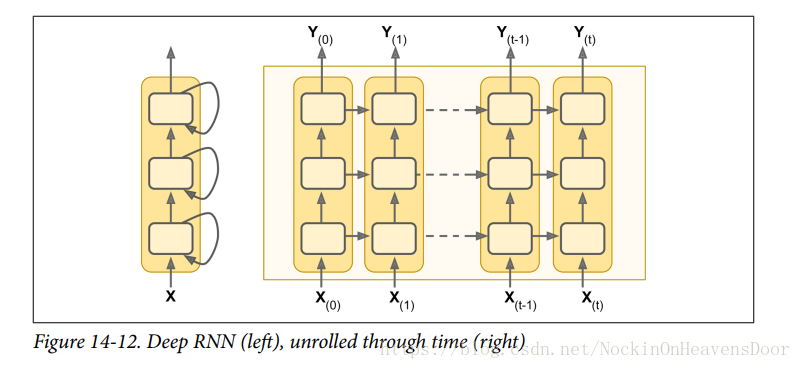
下面叠加三个一样的记忆单元如上图:
# MultiRNNCell
reset_graph()
n_inputs = 2
n_steps = 5
X = tf.placeholder(tf.float32, [None, n_steps, n_inputs])
n_neurons = 100
n_layers = 3
layers = [tf.contrib.rnn.BasicRNNCell(num_units=n_neurons) for layer in range(n_layers)]
multi_layer_cell = tf.contrib.rnn.MultiRNNCell(layers)
outputs, states = tf.nn.dynamic_rnn(multi_layer_cell, X, dtype=tf.float32)
init = tf.global_variables_initializer()
X_batch = np.random.rand(2, n_steps, n_inputs)
with tf.Session() as sess:
init.run()
outputs_val, states_val = sess.run([outputs, states] , feed_dict={X:X_batch})
outputs_val.shape
输出:
(2, 5, 100)注:states是一个元组,其中每一个元素都是最后一层的状态(大小为[batch_size,n_neurons]),一共多少层就多少个元素在这个元组中。
注:tf.contrib.rnn.MultiRNNCell的参数state_is_tuple设为False的话,每层的状态按照列连接上,输出的状态是一个大小为[batch_size,n_layers * n_neurons]的tensor
用dropout防止过拟合
用DropoutWrapper在RNNs的层与层之间使用dropout丢掉部分循环神经元,因为tf.contrib.rnn.DropoutWrapper再测试的时候也会做dropout,所以写的时候要区分train和test,因为tf.contrib.rnn.DropoutWrapper还没有实现类似is_trainable的功能。
reset_graph()
import sys
training = True # in a script, this would be (sys.argv[-1] == "train") instead
X = tf.placeholder(tf.float32, [None, n_steps, n_inputs])
y = tf.placeholder(tf.float32, [None, n_steps, n_outputs])
cells = [tf.contrib.rnn.BasicRNNCell(num_units=n_neurons)
for layer in range(n_layers)]
if training:
cells = [tf.contrib.rnn.DropoutWrapper(cell, input_keep_prob=keep_prob)
for cell in cells]
multi_layer_cell = tf.contrib.rnn.MultiRNNCell(cells)
rnn_outputs, states = tf.nn.dynamic_rnn(multi_layer_cell, X, dtype=tf.float32)
stacked_rnn_outputs = tf.reshape(rnn_outputs, [-1, n_neurons]) # not shown in the book
stacked_outputs = tf.layers.dense(stacked_rnn_outputs, n_outputs) # not shown
outputs = tf.reshape(stacked_outputs, [-1, n_steps, n_outputs]) # not shown
loss = tf.reduce_mean(tf.square(outputs - y)) # not shown
optimizer = tf.train.AdamOptimizer(learning_rate=learning_rate) # not shown
training_op = optimizer.minimize(loss) # not shown
init = tf.global_variables_initializer() # not shown
saver = tf.train.Saver() # not shown
with tf.Session() as sess:
if training:
init.run()
for iteration in range(n_iterations):
X_batch, y_batch = next_batch(batch_size, n_steps) # not shown
_, mse = sess.run([training_op, loss], feed_dict={X: X_batch, y: y_batch}) # not shown
if iteration % 100 == 0: # not shown
print(iteration, "Training MSE:", mse) # not shown
save_path = saver.save(sess, "/tmp/my_model.ckpt")
else:
saver.restore(sess, "/tmp/my_model.ckpt")
X_new = time_series(np.array(t_instance[:-1].reshape(-1, n_steps, n_inputs))) # not shown
y_pred = sess.run(outputs, feed_dict={X: X_new}) # not shown
在时间戳很多时训练的困难
LSTM
长短期记忆单元
直观的看,长短期记忆单元与普通的记忆单元相似,除了一些额外的优势,比如拟合更快还有记录数据的长时依赖性(long-term dependencies)。其结构如图:
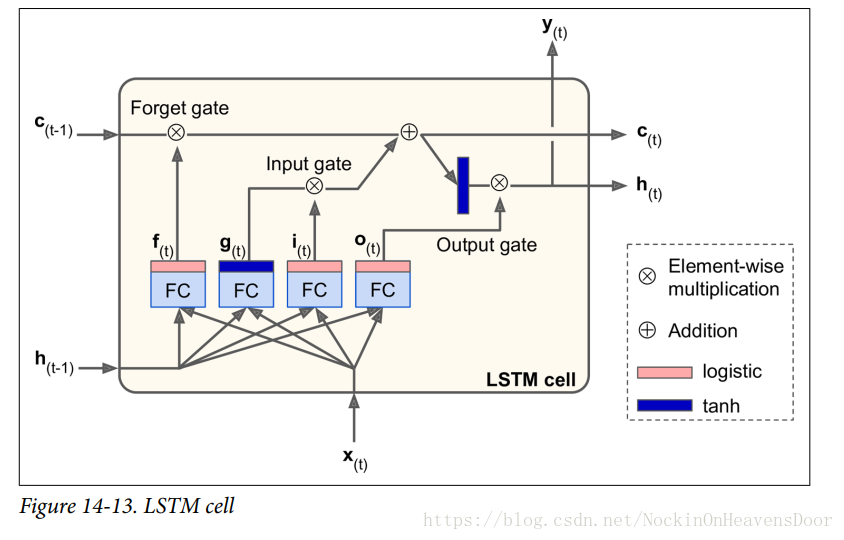
先不看 LSTM 单元内部,跟之前的简单记忆单元相比,LSTM单元的状态分成了两个向量:
(1)
h(t)
h
(
t
)
代表短时状态(short-term state);
(2)
c(t)
c
(
t
)
代表长时状态(long-term state)。
现在看内部,主要观点就是学习一种长时间戳上的依赖性,为此牺牲一部分上一时间戳的数据(即遗忘是最好的记忆)。
(1)长时状态的来源:上一时间戳的长时状态
c(t−1)
c
(
t
−
1
)
从网络左边流向右边,先经过遗忘门(Forget gate)丢掉部分数据(memory),然后加入该时间戳流过来的新数据(new memory),选择哪些新数据由输入门(input gate)决定,然后不做任何变换(the output activation function was omitted,as there was no evidence that it was essential for solving the problems that LSTM had been tested on so far)得到下一时间戳的长时状态
c(t)
c
(
t
)
。在输出
c(t)
c
(
t
)
之前,
c(t)
c
(
t
)
会生成一份拷贝传入一个激活函数tanh,然后由输出门(output gate)进行过滤(逐元素相乘)。
(2)新数据的来源:当前输入向量
x(t)
x
(
t
)
和上一时间戳的短时状态
h(t−1)
h
(
t
−
1
)
被穿入四个不同的全连接层:
- 最主要的层是 g(t) g ( t ) ,它的任务是分析当前输入向量 x(t) x ( t ) 和上一时间戳的短时状态 h(t−1) h ( t − 1 ) ,类似于基本记忆单元的效果。
- 其他三层都是控制门的操作,称为gate controllers,它们的激活函数是logistics,所以输出值范围都在0~1,之后用输出值来做逐元素相乘的操作,所以输出值为0的,相当与关闭门;输出值等于1的,相当于打开门。
forget gate(由
f(t)
f
(
t
)
管理):,控制需要在长时状态中保留的部分。
input gate(由
i(t)
i
(
t
)
管理):,控制需要添加到长时状态的部分。
output gate(由
o(t)
o
(
t
)
管理):,控制在当前时间戳读取和输出长时状态的哪些部分(短时状态
h(t)
h
(
t
)
和当前时间戳输出
y(t)
y
(
t
)
)。
具体计算公式如下:
Equation 14-3: LSTM computations
i(t)f(t)o(t)g(t)c(t)y(t)=σ(WxiT⋅x(t)+WhiT⋅h(t−1)+bi)=σ(WxfT⋅x(t)+WhfT⋅h(t−1)+bf)=σ(WxoT⋅x(t)+WhoT⋅h(t−1)+bo)=tanh(WxgT⋅x(t)+WhgT⋅h(t−1)+bg)=f(t)⊗c(t−1)+i(t)⊗g(t)=h(t)=o(t)⊗tanh(c(t)) i ( t ) = σ ( W x i T ⋅ x ( t ) + W h i T ⋅ h ( t − 1 ) + b i ) f ( t ) = σ ( W x f T ⋅ x ( t ) + W h f T ⋅ h ( t − 1 ) + b f ) o ( t ) = σ ( W x o T ⋅ x ( t ) + W h o T ⋅ h ( t − 1 ) + b o ) g ( t ) = tanh ( W x g T ⋅ x ( t ) + W h g T ⋅ h ( t − 1 ) + b g ) c ( t ) = f ( t ) ⊗ c ( t − 1 ) + i ( t ) ⊗ g ( t ) y ( t ) = h ( t ) = o ( t ) ⊗ tanh ( c ( t ) )
- 其中 Wxi W x i 、 Wxf W x f 、 Wxo W x o 、 Wxg W x g 是与输入向量 x(t) x ( t ) 相乘的各层权重。
- 其中 Whi W h i 、 Whf W h f 、 Who W h o 、 Whg W h g 是与上一时间戳的短时状态 h(t−1) h ( t − 1 ) 相乘的各层权重。
- 其中 bi b i 、 bf b f 、 bo b o 、 bg b g 是四层的各个偏置,注:tensorflow初始化 bf b f 为全1的向量,避免在训练的开始阶段遗忘过多的数据。
变体1:peephole connections
如图:不同之处是,上一时间戳的长时状态
c(t−1)
c
(
t
−
1
)
被用作了遗忘门(forget gate)和输入门(input gate)的输入,如蓝色虚线,然后当前时间戳的长时状态
c(t)
c
(
t
)
被用作了输出门(output gate)的输入,如蓝色实线。
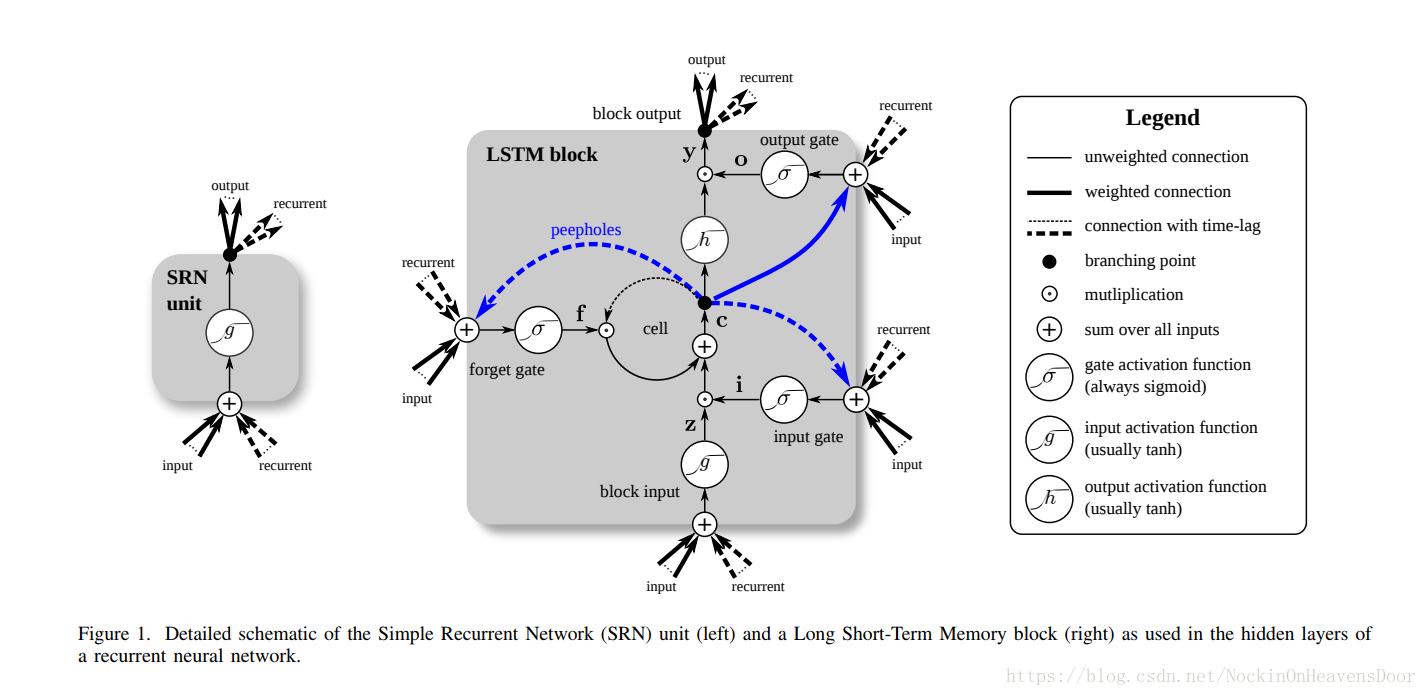
变体2:GRU记忆单元(The Gated Recurrent Unit cell)
如图:是LSTM的一个变体,改变如下:
- 状态向量合并为一个状态向量 h(t) h ( t ) 。
- 遗忘门和输入门由一个门控控制。这个门控输出是1,那输入门打开,遗忘门关闭,因为等于0,输出是0的时候,那遗忘门打开,输入门关闭。(待补充)
- 没有输出门,但全部的状态向量都在每一个时间戳输出。由别的门控控制哪部分输出。(额,不清晰。)
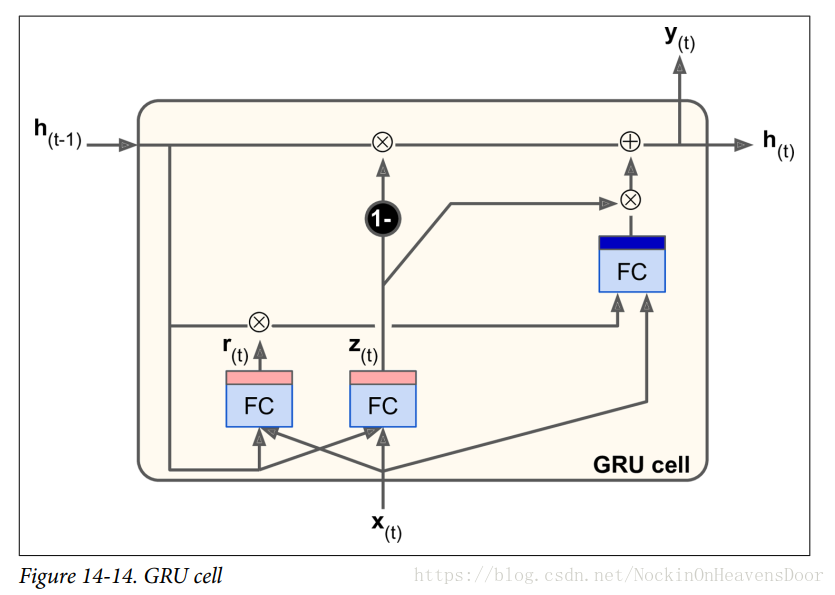
具体计算公式如下:
Equation 14-4: GRU computations
z(t)r(t)g(t)h(t)=σ(WxzT⋅x(t)+WhzT⋅h(t−1))=σ(WxrT⋅x(t)+WhrT⋅h(t−1))=tanh(WxgT⋅x(t)+WhgT⋅(r(t)⊗h(t−1)))=(1−z(t))⊗h(t−1)+z(t)⊗g(t) z ( t ) = σ ( W x z T ⋅ x ( t ) + W h z T ⋅ h ( t − 1 ) ) r ( t ) = σ ( W x r T ⋅ x ( t ) + W h r T ⋅ h ( t − 1 ) ) g ( t ) = tanh ( W x g T ⋅ x ( t ) + W h g T ⋅ ( r ( t ) ⊗ h ( t − 1 ) ) ) h ( t ) = ( 1 − z ( t ) ) ⊗ h ( t − 1 ) + z ( t ) ⊗ g ( t )
tensorflow里的实现:
lstm_cell = tf.contrib.BasicLSTMCell(num_units=n_neurons)加入peephole connections:
lstm_cell = tf.contrib.BasicLSTMCell(num_units=n_neurons, use_peepholes=True)GRU cell:
gru_cell = tf.contrib.rnn.GRUCell(num_units=n_neurons)注:为了计算高效,LSTM单元的实现默认分离两个状态向量,可以设置 state_is_tuple=False 让一个元组保留两个状态。
LSTM识别mnist代码:
reset_graph()
n_steps = 28
n_inputs = 28
n_neurons = 150
n_outputs = 10
n_layers = 3
learning_rate = 0.001
X = tf.placeholder(tf.float32, [None, n_steps, n_inputs])
y = tf.placeholder(tf.int32,[None])
lstm_cell = [tf.contrib.rnn.BasicLSTMCell(num_units=n_neurons)
for layer in range(n_layers)]
multi__cell = tf.contrib.rnn.MultiRNNCell(lstm_cell)
outputs, states = tf.nn.dynamic_rnn(multi__cell, X, dtype=tf.float32)
#-1表示取最后一个层
top_layer_h_state = states[-1][1]
logits = tf.layers.dense(top_layer_h_state, n_outputs, name="softmax")
xentropy = tf.nn.sparse_softmax_cross_entropy_with_logits(labels=y, logits=logits)
loss = tf.reduce_mean(xentropy, name="loss")
optimizer = tf.train.AdamOptimizer(learning_rate)
training_op = optimizer.minimize(loss)
correct = tf.nn.in_top_k(logits, y, 1)
accuracy = tf.reduce_mean(tf.cast(correct, tf.float32))
init = tf.global_variables_initializer()
#3个LSTM层,c是长时状态,h是短时状态
states
输出:
(LSTMStateTuple(c=<tf.Tensor 'rnn/while/Exit_3:0' shape=(?, 150) dtype=float32>, h=<tf.Tensor 'rnn/while/Exit_4:0' shape=(?, 150) dtype=float32>),
LSTMStateTuple(c=<tf.Tensor 'rnn/while/Exit_5:0' shape=(?, 150) dtype=float32>, h=<tf.Tensor 'rnn/while/Exit_6:0' shape=(?, 150) dtype=float32>),
LSTMStateTuple(c=<tf.Tensor 'rnn/while/Exit_7:0' shape=(?, 150) dtype=float32>, h=<tf.Tensor 'rnn/while/Exit_8:0' shape=(?, 150) dtype=float32>))top_layer_h_state
输出:
<tf.Tensor 'rnn/while/Exit_8:0' shape=(?, 150) dtype=float32>n_epochs = 10
batch_size = 150
with tf.Session() as sess:
init.run()
for epoch in range(n_epochs):
for iteration in range(mnist.train.num_examples // batch_size):
X_batch, y_batch = mnist.train.next_batch(batch_size)
X_batch = X_batch.reshape((batch_size,n_steps,n_inputs))
sess.run(training_op, feed_dict={X:X_batch, y:y_batch})
acc_train = accuracy.eval(feed_dict={X:X_batch,y:y_batch})
acc_test = accuracy.eval(feed_dict={X:X_test,y:y_test})
print("Epoch", epoch, "Train accuracy =", acc_train, "Test accuracy =", acc_test)
输出:
Epoch 0 Train accuracy = 0.96 Test accuracy = 0.9539
Epoch 1 Train accuracy = 0.9866667 Test accuracy = 0.9704
Epoch 2 Train accuracy = 0.9866667 Test accuracy = 0.9778
Epoch 3 Train accuracy = 0.96666664 Test accuracy = 0.9788
Epoch 4 Train accuracy = 0.9866667 Test accuracy = 0.981
Epoch 5 Train accuracy = 1.0 Test accuracy = 0.9841
Epoch 6 Train accuracy = 1.0 Test accuracy = 0.9859
Epoch 7 Train accuracy = 1.0 Test accuracy = 0.9851
Epoch 8 Train accuracy = 0.98 Test accuracy = 0.9871
Epoch 9 Train accuracy = 1.0 Test accuracy = 0.9866






 本文深入探讨了循环神经网络(RNN)的基本概念和技术细节,包括记忆单元、输入输出序列、训练技巧、LSTM和GRU单元等。介绍了RNN在序列预测、分类任务中的应用,并提供了详细的实现案例。
本文深入探讨了循环神经网络(RNN)的基本概念和技术细节,包括记忆单元、输入输出序列、训练技巧、LSTM和GRU单元等。介绍了RNN在序列预测、分类任务中的应用,并提供了详细的实现案例。
















 436
436

 被折叠的 条评论
为什么被折叠?
被折叠的 条评论
为什么被折叠?








